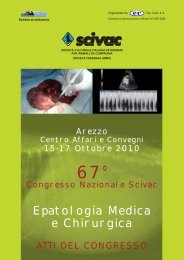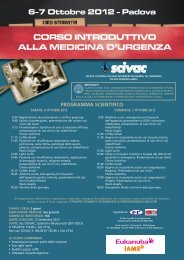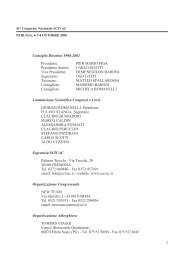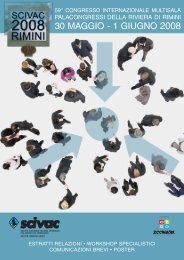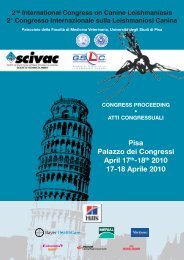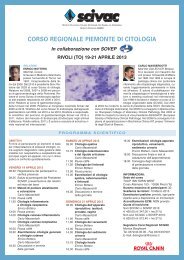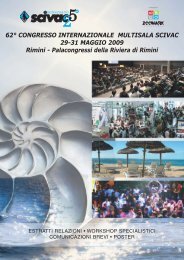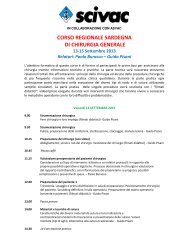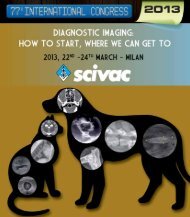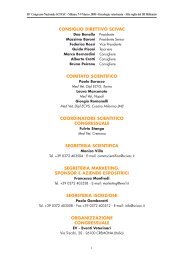68° Congresso Nazionale SCIVAC: Le domande più frequenti in ...
68° Congresso Nazionale SCIVAC: Le domande più frequenti in ...
68° Congresso Nazionale SCIVAC: Le domande più frequenti in ...
You also want an ePaper? Increase the reach of your titles
YUMPU automatically turns print PDFs into web optimized ePapers that Google loves.
<strong>68°</strong> CONGRESSO NAZIONALE <strong>SCIVAC</strong> 11-13 Marzo 2011 - Milano<br />
LE DOMANDE PIÙ FREQUENTI IN RIPRODUZIONE CANINA E FELINA<br />
Tutto quello che i vostri clienti osano spesso chiedere e a cui voi non sapete rispondere<br />
14 th EVSSAR Congress - Advances <strong>in</strong> Fel<strong>in</strong>e Reproduction - March 11 th 2011<br />
piccole porzioni ripetute nella giornata. In commercio esistono diete specifiche<br />
per la gestante o per i cuccioli, caratterizzate da un tenore proteico del 27-<br />
34% (preferibilmente prote<strong>in</strong>e di orig<strong>in</strong>e animale), un m<strong>in</strong>imo di 18% di lipidi<br />
con una quota bilanciata di acidi grassi ω-3 ed ω-6, 20-30% di carboidrati<br />
con un apporto adeguato di m<strong>in</strong>erali e vitam<strong>in</strong>e. È sconsigliata la supplementazione<br />
m<strong>in</strong>erale-vitam<strong>in</strong>ica <strong>in</strong>discrim<strong>in</strong>ata, soprattutto di calcio e vitam<strong>in</strong>a<br />
D, <strong>in</strong> quanto può predisporre la cagna ad eclampsia puerperale e distocia,<br />
nonché causare anomalie nei cuccioli.<br />
Al contrario, diete troppo povere di nutrienti potrebbero non garantire un<br />
corretto apporto energetico e predisporre la cagna all’<strong>in</strong>sorgenza di tossiemia<br />
gravidica.<br />
BIBLIOGRAFIA<br />
Davidson AP (2003). Approaches to reduc<strong>in</strong>g neonatal mortality <strong>in</strong> dogs. In: Recent Advances<br />
<strong>in</strong> Small Animal Reproduction, Concannon PW, England G, Verstegen J. and L<strong>in</strong>de-Forsberg<br />
C. (Eds.) International Veter<strong>in</strong>ary Information Service, Ithaca NY (www.ivis.org);<br />
A1226.0303.<br />
Johnston SD, Root Kustritz MV, Olson PNS (2001). Can<strong>in</strong>e pregnancy. In: Can<strong>in</strong>e and fel<strong>in</strong>e<br />
theriogenology. Johnston SD, Root Kustritz MV, Olson PNS (eds). WB Saunder, Philadelphia.<br />
pp 66-104.<br />
Kutzler MA, Mohammed HO, Lamb SV, Meyers-Wallen VN, (2003). Accuracy of can<strong>in</strong>e parturition<br />
date prediction from the <strong>in</strong>itial rise <strong>in</strong> preovulatory progesterone concentration.<br />
Theriogenology. 60: 1187-1196.<br />
Luvoni GC e Beccaglia M (2006). The Prediction of Parturition Date <strong>in</strong> Can<strong>in</strong>e Pregnancy. Reprod<br />
Dom Anim. 41: 27-32.<br />
Root Kustritz MV (2005). Pregnancy diagnosis and abnormalities of pregnancy <strong>in</strong> the dog Theriogenology.<br />
64: 755-765.<br />
Indirizzo per la corrispondenza:<br />
Michela Beccaglia<br />
E-mail: michela.beccaglia@libero.it<br />
21



